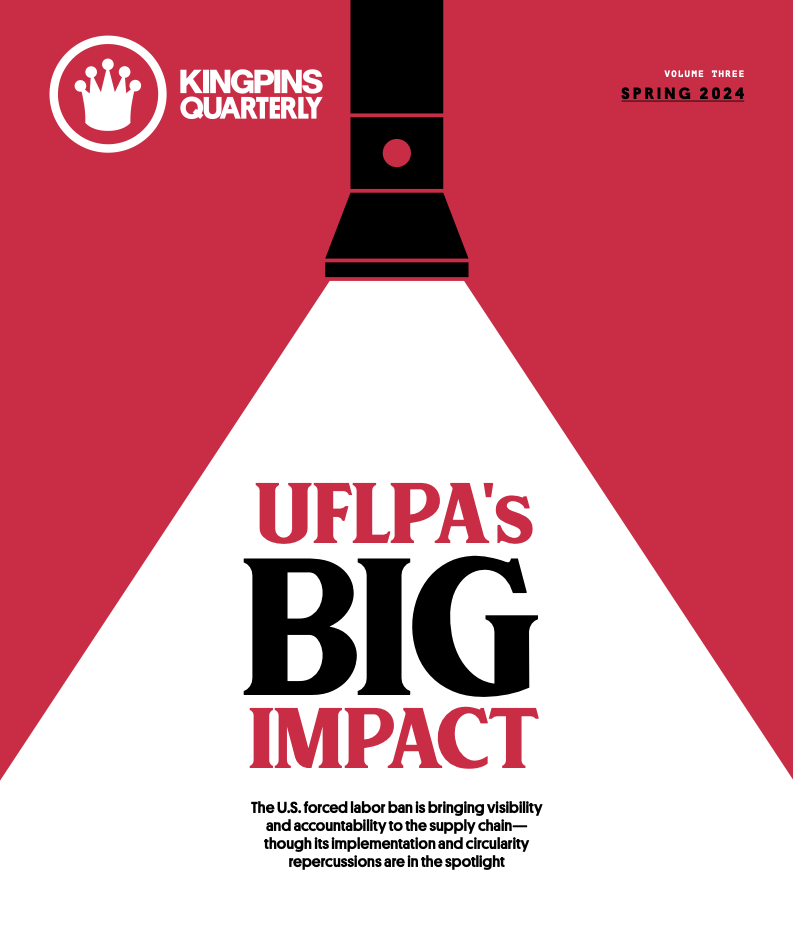Nearshoring is a term that’s tossed around a lot. But thanks to the U.S.-China trade war, forced labor concerns in the Uyghur region, the ongoing Russia-Ukraine conflict and renewed tensions between China and Taiwan, it finally has the potential to maybe, possibly take hold.
In McKinsey & Company’s State of Fashion Report 2023, the consulting firm noted that 65 percent of fashion executives are considering nearshoring for U.S. and EU markets. Further, 35 percent of North American respondents in its Apparel CPO survey said they’re committed to increasing their business in Mexico, specifically.
If the denim industry is serious about not only diversifying but also bringing business back to the Americas, Mexico looks like the destination of choice. Already, U.S. apparel and textile imports from the country were up almost 90 percent in May when compared to the same period in 2022, according to the Commerce Department’s Office of Textiles & Apparel data.
And the reasons why Mexico is poised to continue to take market share from countries like India, Pakistan, Vietnam, Bangladesh and even China is obvious. The country’s proximity to the U.S. means shipments are calculated in hours rather than weeks, and USMCA incentivizes the two countries to work together easily and profitably. All of this translates into dollars saved, greater agility and less risk—the exact trifecta sourcing executives search for.
But Mexico isn’t without its challenges.
Increasing labor rates and a strong peso, in particular, are threatening to make the current interest in the country a short-term flirtation rather than a lasting relationship. And anyone who’s been in denim sourcing over the decades knows there’s a precedent for an influx into Mexico followed by an exodus right back out. However, depending on who you talk to, this time is different.
“We believe in Mexico,” said Murtaza Ahmed, co-founder of Star Fades International. “We also know a lot of companies have allocated 15 percent of their buying budgets for Central America.”
The Los Angeles-based supply chain solutions company, which is owned by Pakistan-based denim manufacturer Artistic Milliners, where Ahmed is a managing director, decided to add Mexico to its nearshoring network at the request of clients looking for quicker turns and therefore less strain on working capital.
Speed is especially important today as the industry continues to struggle with inventory management. Done right, Anatt Finkler, creative director of Mexico-based vertical denim manufacturer Global Denim, said brands can produce to demand in Mexico.
Making the Math Work
But that agility comes at a cost. “Labor rates have increased 42 percent in two years. There’s another labor rate increase starting January 2024 [that’s rumored to be] 10 percent,” said Scott Steuer, president, GD Apparel, where he’s been producing in Mexico and Central America for more than 25 years for brands that include Wrangler, Lee and Dickies. “Are retailers going to pay that?”
These increases are exacerbated by the strength of the peso against the dollar, which hit highs not seen in almost eight years this summer. Though the peso retreated slightly at the end of August, Mexico News Daily reported it was still 12 percent stronger against the dollar heading into September than it was at the beginning of the year.
“Everyone is suffering right now,” Finkler noted. “Mexico was an easy solution because Mexico was so much cheaper than Asia if you’re counting all the shipments and everything. Now it’s getting difficult because manufacturing is getting quite expensive. Because the peso’s rising and the dollar is lower in relationship, it’s hard for [brands] to manufacture in Mexico.”
Despite this, Finkler doesn’t think it’s enough to spark a mass retreat.
“I don’t think brands are going to pull out of Mexico because of this increase right away because they have put so much effort in trying to diversify their supply chain. For now, it might be something that they can accommodate if they have good relationships with manufacturers,” Finkler said. “Even with the difficulties, Asian providers are looking to expand here, and that tells you something, right? I think it’s going to be a bump in the road.”
Arlethe Sánchez, marketing manager for Mexico-based Tavex, continues to see an influx of sourcing companies scouting production possibilities in Mexico.
“The huge brokers like Crystal and PPJ that are producing in China or in Asia need to change their production here. These brokers are already in Mexico [searching for] very good fabrics and manufacturers with the best quality and ethics,” Sánchez said, noting that these companies are sourcing on behalf of big names like Macy’s, Target and Gap.
PPJ Group’s vertical operations is headquartered in Vietnam and partners with factories across the globe in countries like Guatemala, Egypt, Bangladesh and Cambodia. Hong Kong-based Crystal Group operates production facilities across five countries, including Bangladesh, China and Vietnam. She said getting these brands up and running is a multiyear process but she sees Mexico, along with Argentina, as natural beneficiaries of diversification.
But this isn’t the first time denim—and the apparel industry at large—has turned its attention to Mexico. Unfortunately, in the past it proved to be short lived. Now there’s more motivation to stick it out, according to Ahmed.
“Post COVID, a lot of supply chain managers and sourcing managers learned that they need to have a diversified strategy. It’s no longer about cost only. It’s about reliability. It’s about speed. It’s about diversification,” he said.
While the pandemic was a shock that sent brands and retailers scrambling to Mexico when their shipments from Asia languished for months at the ports, Steuer is less optimistic that the industry is ready to invest in Mexico in a sustained way.
“There’s always this discussion every 10 to 12 years of nearshoring and this time we hope that it takes shape as much as it’s being talked about,” Steuer said. One reason is price, he said, and it continues to be a stumbling block today.
“They’re sending droves of people into Mexico to the fabric mills. The fabric mills are suggesting factories and the factories are talking to the thread suppliers. Downstream everyone’s all excited. But when the target prices aren’t realistic to what the labor rates mandate, then we don’t know how the business can materialize,” he said.
One reason is brands are often not comparing apples to apples when they’re stacking Asia pricing up against Mexico’s, Steuer said.
“There is no such thing as the old school mentality of sourcing a garment price by the minutes it takes to make a garment because there’s not enough consistency. We don’t have the million units anymore in this hemisphere, where you’re running sewing lines of 25,000, 50,000 or 75,000 of the same garment a week,” he said. Instead, factories are producing lower volumes of more SKUs, which impacts efficiency—and ultimately costs. “It doesn’t matter what country you’re in. If you don’t have the economies of scale, you can’t automate equipment, and you can’t compete price-wise.”
Taking everything into consideration—lower tariffs, reduced logistics and improved product relevance—Mexico is comparable to its overseas competitors but the industry’s continued focus on first costs can make it a tough sell. Even if the country had the capacity to match the interest, Ahmed said, it wouldn’t all convert to business due to the price.
It’s a short-sighted view, he said, pointing out that the reality is quicker turns means better buying decisions. It doesn’t help to pay 25 percent less in Asia if the lead time means the product is obsolete by the time it arrives. At that point, he said, you’re marking the goods down by at least 25 percent to get them out the door.
It’s new math for an industry conditioned to look for the cheapest needle, but it’s catching on.
“The leadership has embraced the idea of margin growth rather than first cost. And it’s slowly trickling down to the sourcing level, which are the people that make decisions. So, we’re on our way,” Ahmed said.
Positioning for the future
Denim’s commitment to sustainability is another factor that should keep Mexico top of mind for sourcing executives, according to Finkler.
“When we’re talking about sustainability, a lot of big companies forget that they can be applying a thousand different sustainability, raw materials methods, whatever, but at the end, you’re still producing in China, Pakistan, Bangladesh, and it just erases any sustainability efforts you just made,” she said, referring to the carbon footprint created by delivering goods from Asia.
From her perspective, Mexico will continue to gain market share as long as the mills there focus on sustainability. The key to winning U.S. and EU business is “thinking about future investments all the time [and] bringing outside expertise inside,” Finkler said. To that end, Global Denim, whose clients include Kontoor Brands and Levi’s, focuses on education.
Sánchez agreed and said Tavex, which supplies leading brands in the U.S., is continuously upgrading and is currently in the process of purchasing new laundry machines that are even more eco-friendly. But given the scale of investments like those, she said the apparel industry could use some help to accelerate change.
“We have the sustainable part covered, and nowadays the regulations are very, very strict. We have several government officers that are in charge of the environment part, but we need to change the innovation of our machinery,” she said. “The government has a very important part here to provide the financing products [so that we can have] access to that money to make the change.”
Luis Torres, senior business economist for the Federal Reserve Bank of Dallas, also noted infrastructure as a major miss nationally.
“Mexico is lacking some more investment in infrastructure [and] more policies oriented to that sustainability. That’s been a major issue. They need to build architectural sustainability—more bridges on the border, [investment in] customs, roads, airports,” he said, noting a nixed airport project that would have connected South America to Mexico, making Mexico a major hub. “That’s where the government’s lacking.”
In the meantime, Torres said state governments are stepping up to make their regions more attractive.
Short of investments of this kind, the best thing the Mexican government can do is maintain the current relationship with the U.S. Despite the inherent uncertainty that major elections on both sides of the border next year bring, Torres is confident both countries can agree there’s no upside in rocking the boat.
“If the new administration that comes in wants to continue with the trade war with China, it would be counterproductive to try to raise tariffs with Mexico or to try to change USMCA,” he said. “It would be like shooting yourself in the foot.”
Avedis Seferian, president and CEO of Worldwide Responsible Accredited Production (WRAP), agrees that more of the same is exactly what will allow Mexico to continue to take market share.
“Business in general, and especially this industry more than most, values stability above pretty much all else. Uncertainty is the most painful. So, for any government, Mexico included, my advice would be to create a stable environment that becomes dependable, reliable and can be expected to stay that way for a nice planning period to allow for wider horizons for investment thinking—for longer term thinking,” Seferian said.
Given the current outlook, Mexico continues to check all of the boxes for denim sourcing managers looking to dodge political uncertainty, social instability, logistics bottlenecks and prohibitive tariffs. Only time will tell if these benefits will outweigh the costs associated with doing business there.
For those brands intent on nearshoring, Ahmed said, there’s really only one clear solution.
“I don’t think Mexico has any competition to be honest. There is no place in the world that can make jeans and cross the border in six hours,” he said, pointing to the limited capacity of a place like Guatemala and the political instability of Nicaragua and Honduras. “Mexico is a complete vertical solution from yarn to finish garments. It is a country that is difficult to beat at this point.”




